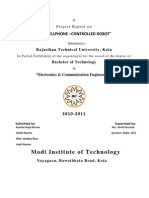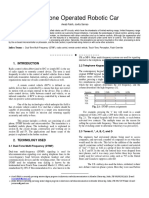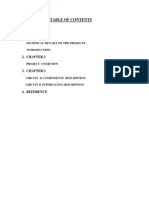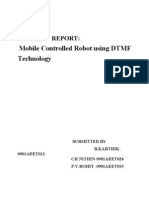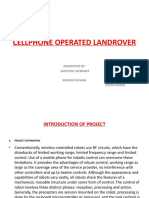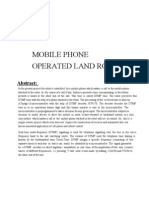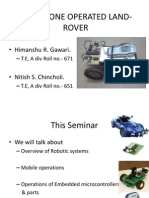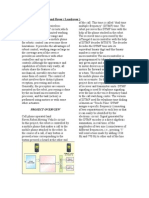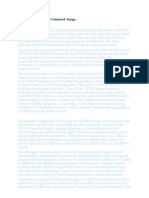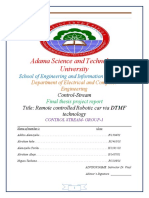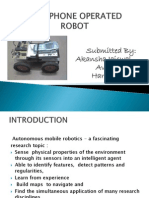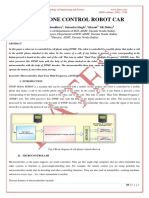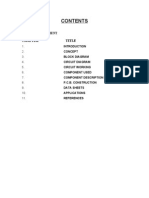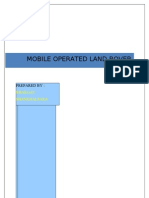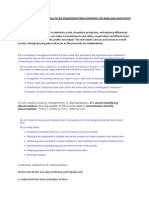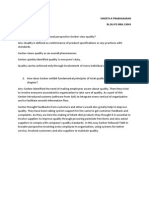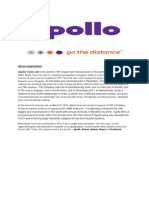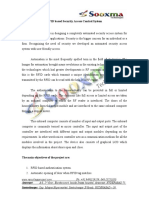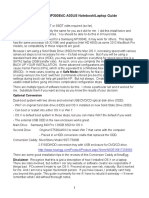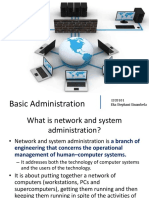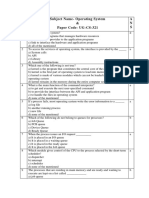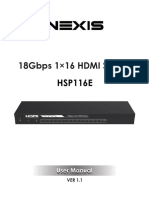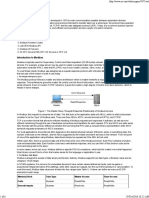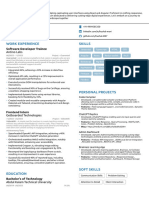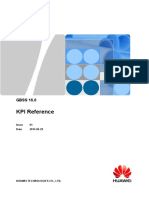Cellphone Operated Robot
Mini Project Report 2011
1. INTRODUCTION
Radio control (often abbreviated to R/C or simply RC) is the use of radio signals to remotely control a device. The term is used frequently to refer to the control of model vehicles from a handheld radio transmitter. Industrial military ! scientific research organi"ations ma#e $traffic% use of radio-controlled vehicles as &ell. ' remote control vehicle is defined as any mobile device that is controlled by a means that does not restrict its motion &ith an origin e(ternal to this device. This is often a radio control device cable bet&een control and vehicle or an infrared controller. ' remote control vehicle (also called an RC)) differs from a robot in that the RC) is also controlled by a human and ta#es no positive actions autonomously. *ne of the #ey technologies &hich underpin this field is that of remote vehicle control. It is vital that the vehicle should be capable of proceeding accurately to a target area+ maneuvering &ithin that area to fulfill its mission and returning equally accurately and safely to base. Radio is the most popular because it does not require the vehicle to be limited by the length of the cable or in a direct line of sight &ith the controller as &ith the infrared setup. ,luetooth is too e(pensive and short range to be commercially viable.
�Cellphone Operated Robot
Mini Project Report 2011
2. PRODUCT DESIGN
The design of product is a laborious tas# &hich ta#es much of immense creative s#ills bringing out artist and designer &ithin an engineer. -e is directed by a(ioms of industrial designs &hich are .. The user one &ho e(periences the need /. The user &ho is only constant 0. The user &ho is final datum
ELEMENTS OF DESIGN AESTHETICS It is the study of theories that apply to the arts in a broad and fundamental &ay. It means having to do &ith beautiful as distinguished for the useful scientific or moral based on or determined by the beauty rather than by practical or moral considerations. 1hile considering the designing of a product it should have a good appearance. ,eauty is one of the pea# things that determine the mar#et of a product.
'23T-2TIC3
456CTI*6
9R*:5CT
2R7*6*8IC3
�Cellphone Operated Robot
Mini Project Report 2011
ERGONOMICS It is the study of engineering that deals &ith the relationship bet&een beauty and &or#ing of a product. ' product should not ;ust have a good appearance also it should be able to &or# properly. It emphasi"es the basic requirements. 3afety of the product Reliability of the product 2ase of handling <o& physiological cost 2R7*6*8IC3 in industrial design finds application in Control panel design 2nclosure design 1or#space design FUNCTION 4unction implies the activity or purpose of a product. ,efore designing a product its function have to be &ell defined so that it can be designed to &or# accordingly under all considerations. 'part from the three elements of design t&o other factors are to be considered &hile designing a product their cost and reliability. The product should have ma(imum reliability at minimum cost.
�Cellphone Operated Robot
Mini Project Report 2011
�Cellphone Operated Robot
Mini Project Report 2011
3.
BLOCK DIAGRAM
4I7. 0.. ,loc# :iagram of the Circuit
DESCRIPTION
�Cellphone Operated Robot
Mini Project Report 2011
The robot is controlled by a mobile phone that ma#es a call to the mobile phone attached to the robot. In the course of a call off any button is pressed a tone corresponding to the button pressed is heard at the other end of the call. This tone is called dual tone multiple frequency (:T84) tone. The robot perceives this :T84 tone &ith the help of the phone stac#ed in the robot. The received tone is processed by the 'T827'.= microcontroller &ith the help of :T84 decoder 8T>>?@. The decoder decodes the :T84 tone into its equivalent binary digit and this binary number is send to the microcontroller. The microcontroller is pre-programmed to ta#e a decision for any given input and output its decision to motor drivers inorder to drive the motors for for&ard or bac#&ard motion or a turn. The mobile that ma#es a call to the mobile stac#ed in the robot acts as a remote. 3o the construction of receiver and transmitter units is not required. The :T84 signaling is used for telephone signalling over the line in the voice frequency band to the call s&itching centre. The version of :T84 used for telephone tone dialing is #no&n as touch tone. :T84 assigns a specific frequency to each #ey so that it can easily be identified by the electronic circuit. The signal generated by the :T84 encoder is a direct algebraic summation of the amplitudes of t&o sine &aves of different frequencies i.e. pressing A &ill send a tone made by adding .00=-" and ??@-" to the other end of the line. TABLE 3.1 DTMF DATA OUTPUT
�Cellphone Operated Robot
Mini Project Report 2011
�Cellphone Operated Robot
Mini Project Report 2011
4. TECHNOLOGY USED
Dual-To ! Mul"#-F$!%u! &' (DTMF) :ual-tone multi-frequency (:T84) signalling is used for telecommunication signalling over analog telephone lines in the voice-frequency band bet&een telephone handsets and other communications devices and the s&itching center. T!l!*+o ! K!'*a, The contemporary #eypad is laid out in a 0(B grid although the orginal :T84 #eypad had an additional column for four #eys. 1hen used to dial a telephone number pressing a single #ey &ill produce a pitch consisting of t&o simultaneous pure tone sinusoidal frequencies. The ro& in &hich the #ey appears determines the lo& frequency and the caller determines the high frequency. The multiple tones are the reason for calling the system multifrequency. Then these tones can be decoded.
4I7. B.. ' :T84 Telephone Ceypad
�Cellphone Operated Robot
Mini Project Report 2011
TABLE 4.1 DTMF K!'*a, F$!%u! &#!- (.#"+ Sou , Cl#*-) ./@D -" =D? -" ??@ -" >A/ -" DB. -" . B ? E .00= -" / A > @ .B?? -" 0 = D F .=00 -" ' , C :
�Cellphone Operated Robot
Mini Project Report 2011
/. CIRCUIT DIAGRAM
4I7.A.. Circuit :iagram
10
�Cellphone Operated Robot
Mini Project Report 2011
/.1 DECODER CIRCUIT
4I7.A./ :T84 :2C*:2R CIRC5IT
'n 8T>>?@ series :T84 decoder is used here. 'll type of 8T>>?@ series use digital counting techniques to detect and decode all the .= :T84 tone pairs into a B bit call output. The built-in dial tone re;ection circuit eliminates the need for pre-filtering. 1hen the input signal given at pin / in single ended input configuration is recognised to be effective the correct B bit decode signal of the :T84 tone is transferred to G. through GB outputs. G. through GB outputs of the :T84 decoder are connected to port pins 9'@ through 9'0 of 'T827'.= microcontroller after inversion by 6. through 6B respectively.
11
�Cellphone Operated Robot
Mini Project Report 2011
/.2 MICROCONTROLLER CIRCUIT
4I7.A.0 I6T2R4'CI67 CIRC5IT The 'T827'.= is a lo& po&er >-bit C8*3 microcontroller based on the ')R enhanced RI3C architecture. It provides the follo&ing featuresH .=#, of in-system programmable flash program memory &ith read-&hile-&rite capabilities A./ bytes of 229R*8 .#, 3R'8 0/ general purpose i/o lines and 0/ general purpose &or#ing registers. 'll the 0/ registers are directly connected to the arithmetic logic unit allo&ing t&o independent registers to be accessed in one single instruction e(ecuted in one cloc# cycle. The resulting architecture is more code-efficient. *utputs from port pins 9:@ through 9:0 and 9:? of the microcontroller are fed to inputs I6. through I6B and enable pins (26. and 26/) of motor driver </D0: respectively to drive t&o :C motors. 3&itch 3. is used for manual reason. The microcontroller output is not sufficient to drive the :C motors so current drivers are required for motor rotation.
12
�Cellphone Operated Robot
Mini Project Report 2011
/.3 MOTOR DRI0ER CIRCUIT
4I7.A.B 8otor :river Circuit The </D0: is a Guad high current half-- driver designed to provide bi-directional drive currents up to =@@m' at voltages from B.A) to 0=). It ma#es it easier to drive the :C motors. The </D0: consists of B drivers. 9ins I6. through I6B and *5T. through *5TB are input and output pins respectively of driver . through driver B. :rivers . ! / and drivers 0 ! B are enabled by enable pin . (26.) and pin D (26/) respectively. 1hen enable input 26. (pin .) is high drivers . ! / are enabled and outputs corresponding to their inputs are active. 3imilarly enable input 26/ (pin D) enables drivers 0 ! B.
13
�Cellphone Operated Robot
Mini Project Report 2011
1. .ORKING
In order to control the robots &e need to ma#e a call to the cellphone attached to the robot (through head phone) from any phone &hich sends :T84 tones on pressing the numeric buttons. The cellphone in the robot is #ept in Iauto ans&erJ mode. (If the mobile does not have the auto ans&ering facility receive the call by I*CJ #ey on the rover-connected mobile and then made it in hands-free mode.) 3o after a ring the cellphone accepts the call. The :T84 tones thus produced are received by the cellphone in the robot. These tones are fed to the circuit by the headset of the cellphone. The 8T>>?@ decodes the received tones and sends the equivalent binary number to the microcontroller. 'ccording to the program in the microcontroller robot starts moving. 'ctions of the motors are listed in table =...
TABLE 1.1 A&"#o - *!$2o$3!, &o$$!-*o ,# 4 "o "+! 5!'- *$!--!, Nu36!$ *$!--!, 6' u-!$ / B = > A Ou"*u" o2 MT7789 DTMF ,!&o,!$ @(@/ @@@@@@.@ @(@B @@@@@.@@ @(@= @@@@@..@ @(@> @@@@.@@@ @(@A @@@@@.@. I *u" "o "+! 3#&$o-&o "$oll!$ @(4: ......@. @(4, .....@.. @(4D .....@@. @(4? ....@... @(4' .....@.@ Ou"*u" 2$o3 3#&$o-&o "$oll!$ @(>D .@@@.@@. @(>A .@@@@.@. @(>' .@@@.@.@ @(>= .@@@@..@ @(@@ @@@@@@@@ A&"#o *!$2o$3!, 4or&ard motion <eft turn Right turn ,ac#&ard motion 3top
8. SOFT.ARE SECTION
14
�Cellphone Operated Robot
Mini Project Report 2011
The soft&are is &ritten in ICJ language and compiled using Code )ision ')R ICJ compiler. The source program is converted into he( code by the compiler. ,urn this he( code into 'Tmega.= ')R microcontroller. The source program is &ell commented and easy to understand. 4irst include the register name defined specifically for 'Tmega.= and also declare the variable. 3et port ' as the input and port : as the output. The program &ill run forever by using I&hileJ loop. 5nder I&hileJ loop read port ' and test the received input using Is&itchJ statement. The corresponding data &ill output at port : after testing of the received data. 9roteus I3I3 is used for designing and simulating the circuit. 8.1 FLO. CHART
4I7. ?.. 4lo& Chart of the 9rogram
8.2 ATMEGA11 MICROCONTROLLER PROGRAM
15
�Cellphone Operated Robot
Mini Project Report 2011
FincludeKavr/io.hL void main(void) M unsigned int h #+ ::R'N@(@@+ ::R:N@(44+ &hile(.) M #NO9I6'+ hN#!@(@4+ s&itch(h) M case @(@/H M 9*RT:N@(>D+ brea#+ P case @(@>H M 9*RT:N@(>=+ brea#+ P case @(@BH M 9*RT:N@(>A+ brea#+ P case @(@=H M 9*RT:N@(>'+ brea#+ P
16
//Set port A as input port //Set port D as output port
//If input is 0x02 //Output 0x89 i.e., Forward
//If input is 0x08 //Output 0x86 i.e., Backward
//If input is 0x0 //Output 0x8! i.e., "eft turn
//If input is 0x06 //Output 0x8A i.e., #i$%t turn
�Cellphone Operated Robot
Mini Project Report 2011
case @(@AH M 9*RT:N@(@@+ brea#+ P P P P
//If input is 0x0! //Output 0x00 i.e., Stop
17
�Cellphone Operated Robot
Mini Project Report 2011
7. SOFT.ARES USED
7.1 PROTEUS-ISIS 9roteus is soft&are for microprocessor simulation schematic capture and printed circuit board (9C,) design. It is developed by <abcenter 2lectronics. I3I3 lies at the heart of the 9roteus system and is far more than ;ust another schematics pac#age. It combines a po&erful design environment &ith the ability to design most aspects of the dra&ing appearance.
F!a"u$!- o2 P$o"!u- ISIS 3upports large no. of microcontroller units (8C5s) including 'T827'.=. 7enerating the proper signals for motor controller. -uge gallery of circuit components. 2lectromechanical components li#e :C motors can be simulated. -e( file can be loaded directly to the 8C5 and observe the result. <ogic analyser facility
7.2 A0R S"u,#o 4.9 ')R 3tudio B.@ is a free professional integrated development environment for &riting and debugging 'T82< ')R applications in 1indo&s environments. It includes an assembler and simulator as &ell as integration &ith the 1in')R 765 7CC C and CQQ compiler for ')R microcontrollers.
18
�Cellphone Operated Robot
Mini Project Report 2011
F!a"u$!- o2 A0R S"u,#o 4.9 9rogram can be &ritten in both C and assembly language. 4lags Timers 9orts and Register ban# can be observed directly. -e( files can be generated. 2asy debugging and troubleshooting. 7.3 .ELLON 12<<*6 is the soft&are used for burning the 8C5 units. It is soft&are compatible &ith 1indo&s. The soft&are is associated &ith the 12<<*6 advanced programmer &ith the state of the art architecture &ith on-board high speed C95 RT*3 497' C9<: and high quality universal pin drivers. The soft&are is user-friendly. It has auto-count batch command Insertion-and-start features.
19
�Cellphone Operated Robot
Mini Project Report 2011
:. PCB FABRICATION
:.1 PCB DESIGN 9rinted circuit boards or 9C,s form the core of electronic equipment-domestic and industrial. 3ome of the areas &here 9C,s are intensively used are computers process control telecommunications and instrumentation MANUFACTURING The manufacturing process consists of t&o methods-print and etch+ print plate and etch. 3ingle sided 9C,s are usually made using the print and etch method. The double sided plate through hole (9T-) boards are made by the print plate and etch method. The production of multi layer boards uses both the methods. The inner layers are printed and etched &hile the outer layers are produced by print plate and etch after pressing the inner layers. SOFT.ARE The soft&are used in our pro;ect to obtain the schematic layout is <I)21IR2. PENALISATION -ere the schematic is transformed into the &or#ing positive/negative films. The circuit is repeated conveniently to accommodate economically as many circuits as possible in a panel &hich can be operated in every sequence of subsequent steps in the 9C, process. This is called penalisation. 4or the 9T- boards the ne(t operation is drilling. DRILLING 9C, drilling is the state of the art operation. )ery small holes are drilled &ith high speed C6C drilling machines giving a &all finish &ith less or no smear or epo(y required for void free through hole plating.
20
�Cellphone Operated Robot
Mini Project Report 2011
PLATING The heart of 9C, manufacturing process. The holes drilled in the board are treated both mechanically and chemically before depositing the copper by the electro less copper plating process. ETCHING *nce a multilayer board is drilled and electro less copper deposited the image available in the form of a film is transferred on to the outside by photo printing using a dry film printing process. The boards are then electrolytically plated on to the circuit pattern &ith copper and tin. The tin plated deposit serves an etch resist &hen copper in the un&anted area is removed by the conveyorJs spray etching machines &ith chemical etchants. The etching machines are attached to an automatic dosing equipments &hich analyses and controls etchants concentration. :.2 SOLDERING It is the process of ;oining by heat using a filler material for the purpose of ma#ing continuous and permanent path for the flo& of electricity. SOLDER MASK 3ince a 9C, design may call for very close spacing bet&een conductors a solder mas# has to be applied on both sides of the circuitry to avoid the bridging of conductors. The solder mas# in# is applied by screening. The in# is dried e(posed to 5) developed in a mild al#aline solution and finally cured by both 5) and thermal energy. HOT AIR LE0ELLING 'fter applying the solder mas# the circuit parts are soldered using the hot air levelling process. The bare bodies flu(ed and dipped into a molten solder bath. ,y removing the board from the solder bath hot air is blo&n on both sides of the board through air #nives in the machines leaving the soldered and levelled. This is one of the common finishes given to the boards. Thus the hole printed circuit board is manufactured and is no& ready for the components to be soldered.
21
�Cellphone Operated Robot
Mini Project Report 2011
:.3 PCB LAYOUT
4I7.D.. 9C, <ayout
22
�Cellphone Operated Robot
Mini Project Report 2011
4I7.D./ Component <ayer
23
�Cellphone Operated Robot
Mini Project Report 2011
19. BILL OF MATERIALS
Ta6l! 19.1 3l.no Component . Resistor - .@ / 0 B A = Resistor - .@@# Resistor - 00@# Crystal *scillator - 0.A?8-" Crystal *scillator - ./8-" Capacitor - @.. 4 Rate Rs.. Rs.. Rs.. Rs.B Rs.> Rs.. Rs.. Rs.. Rs.=@ Rs./A@ Rs..A Rs./A Rs.A Rs.>@ Rs.. Rs.B@ Rs.=@@ Guantity Total A Rs.A / . . . . Rs./ Rs.. Rs.B Rs.> Rs..
? Capacitor - @.B? 4 > D .@ .. ./ .0 .B .A .= .? Capacitor - //p4 IC - 8T>>?@ IC - 'T827'.= IC - ?B@B IC - </D0: 3&itch =) :C 8otor :iode R .6B@@? ../) :C ,attery 9C, 4abrication 7R'6: T*T'<
. Rs.. B . . . . . / . A . Rs.B Rs.=@ Rs./A@ Rs..A Rs./A Rs.A Rs..=@ Rs.. Rs./@@ Rs.=@@ Rs..0B/
24
�Cellphone Operated Robot
Mini Project Report 2011
11. APPLICATIONS
SCIENTIFIC Remote control vehicles have various scientific uses including ha"ardous environments &or#ing in the deep ocean and space e(ploration. The ma;ority of the probes to the other planets in our solar system have been remote control vehicles although some of the most recent ones &ere partially autonomous. The sophistication of these devices has fueled greater debate on the need for manned space flight and e(ploration.
MILITARY AND LA. ENFORCEMENT 8ilitary usage of remotely controlled military vehicles dates bac# to the first half of /@ th century. 3oviet Red 'rmy used remotely controlled Teletan#s during .D0@s in the 1inter &ar and early stage of 1orld 1ar II.
SEARCH AND RESCUE 5')s &ill li#ely play an increased role in search and rescue in 5nited 3tates. This &as demonstrated by the successful use of 5')s during the /@@> hurricanes that struc# <ouisiana and Te(as.
25
�Cellphone Operated Robot
Mini Project Report 2011
12. MERITS AND DEMERITS
MERITS 1ireless control. )ehicle navigation &ith use of 07 technology. Ta#es in use of the mobile technology &hich is almost available every&here. This &ireless device has no boundation of range and can be controlled as far as net&or# of cellphone. DEMERITS Cellphone bill. 8obile batteries drain out early so charging problem. Cost of pro;ect increase if cellphone is included. 6ot fle(ible &ith all cellphones as only a particular cellphone &hose earpiece is attached can only be used.
26
�Cellphone Operated Robot
Mini Project Report 2011
13. RESULT AND CONCLUSION
1e are glad to say that a fully &or#ing model of our pro;ect S CELLPHONE OPERATED ROBOTT &as put into operation. This could help us to e(pand our technical hori"on.
27
�Cellphone Operated Robot
Mini Project Report 2011
14. FUTURE SCOPE OF THE PRO;ECT
1. IR S! -o$-< IR sensors can be used to automatically detect ! avoid obstacles if the robot goes beyond line of sight. This avoids damage to the vehicle if &e are maneuvering it from a distant place. 2. Pa--=o$, P$o"!&"#o < 9ro;ect can be modified in order to pass&ord protect the robot so that it can be operated only if correct pass&ord is entered. 2ither cell phone should be pass&ord protected or necessary modification should be made in the assembly language code. This introduces conditioned access ! increases security to a great e(tent. 3. Ala$3 P+o ! D#all!$< ,y replacing :T84 :ecoder IC 8T>>?@ by a :T84 Transceiver IC
C8>>>@ :T84 tones can be generated from the robot. 3o an 'larm 9hone :ialler can be built &hich &ill generate necessary alarms for something that is desired to be monitored (usually by triggering a relay). 4or e(ample a high &ater alarm lo& temperature alarm opening of bac# &indo& garage door etc. 1hen the system is activated it &ill call a no. of programmed numbers to let the user #no& the alarm has been activated. This &ould be great to get alerts of alarm conditions from home &hen user is at &or#. 4. A,,# 4 a &a3!$a< If the current pro;ect is interfaced &ith a camera (e.g. a 1ebcam) robot can be driven beyond line-of-sight ! range becomes practically unlimited as 738 net&or#s have a very large range.
28
�Cellphone Operated Robot
Mini Project Report 2011
1/. REFERENCE
..
1i#ipedia R The free encyclopedia
/.
httpH//#itsnspares.com/admin/pdffiles/CellphoneU<andV/@Rover.pdf
0.
httpH//&&&.datasheetcatalog.com/datasheetsUpdf/?/B/</3/?B<3@B.shtml
B.
httpH//pdf..alldatasheet.com/datasheet-pdf/?>A0//'T82</'T827'.=.html
A.
httpH//pdf..alldatasheet.com/datasheet-pdf/vie&/??@>A/8IT2</8T>>?@.html
=.
httpH//pdf..alldatasheet.com/datasheet-pdf/vie&//?.>D/TI/</D0:.html
29
�Cellphone Operated Robot
Mini Project Report 2011
11. APPENDI>
30
